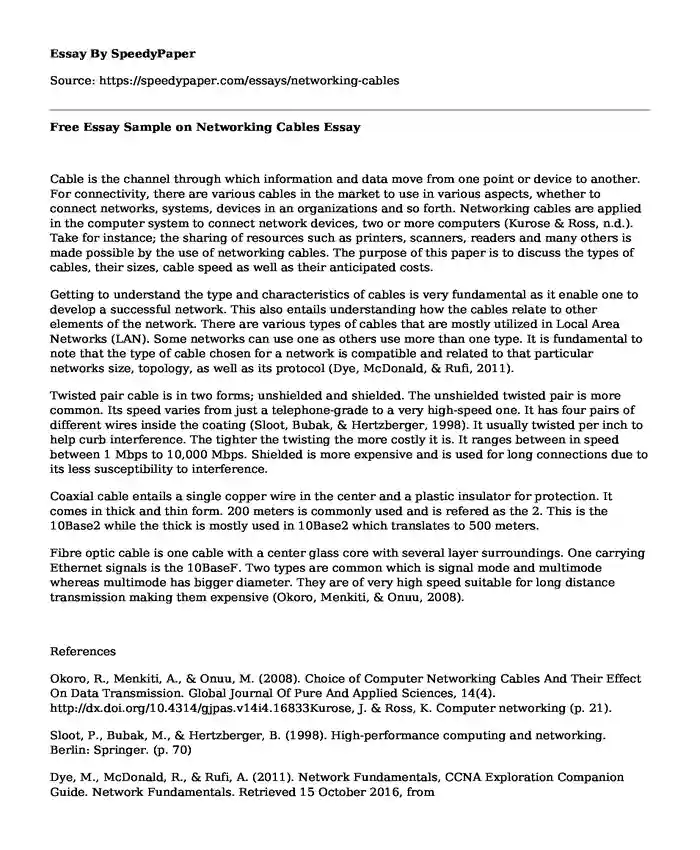
| Type of paper: | Essay |
| Categories: | Computer science Electronics |
| Pages: | 2 |
| Wordcount: | 476 words |
Cable is the channel through which information and data move from one point or device to another. For connectivity, there are various cables in the market to use in various aspects, whether to connect networks, systems, devices in an organizations and so forth. Networking cables are applied in the computer system to connect network devices, two or more computers (Kurose & Ross, n.d.). Take for instance; the sharing of resources such as printers, scanners, readers and many others is made possible by the use of networking cables. The purpose of this paper is to discuss the types of cables, their sizes, cable speed as well as their anticipated costs.
Getting to understand the type and characteristics of cables is very fundamental as it enable one to develop a successful network. This also entails understanding how the cables relate to other elements of the network. There are various types of cables that are mostly utilized in Local Area Networks (LAN). Some networks can use one as others use more than one type. It is fundamental to note that the type of cable chosen for a network is compatible and related to that particular networks size, topology, as well as its protocol (Dye, McDonald, & Rufi, 2011).
Twisted pair cable is in two forms; unshielded and shielded. The unshielded twisted pair is more common. Its speed varies from just a telephone-grade to a very high-speed one. It has four pairs of different wires inside the coating (Sloot, Bubak, & Hertzberger, 1998). It usually twisted per inch to help curb interference. The tighter the twisting the more costly it is. It ranges between in speed between 1 Mbps to 10,000 Mbps. Shielded is more expensive and is used for long connections due to its less susceptibility to interference.
Coaxial cable entails a single copper wire in the center and a plastic insulator for protection. It comes in thick and thin form. 200 meters is commonly used and is refered as the 2. This is the 10Base2 while the thick is mostly used in 10Base2 which translates to 500 meters.
Fibre optic cable is one cable with a center glass core with several layer surroundings. One carrying Ethernet signals is the 10BaseF. Two types are common which is signal mode and multimode whereas multimode has bigger diameter. They are of very high speed suitable for long distance transmission making them expensive (Okoro, Menkiti, & Onuu, 2008).
References
Okoro, R., Menkiti, A., & Onuu, M. (2008). Choice of Computer Networking Cables And Their Effect On Data Transmission. Global Journal Of Pure And Applied Sciences, 14(4). http://dx.doi.org/10.4314/gjpas.v14i4.16833Kurose, J. & Ross, K. Computer networking (p. 21).
Sloot, P., Bubak, M., & Hertzberger, B. (1998). High-performance computing and networking. Berlin: Springer. (p. 70)
Dye, M., McDonald, R., & Rufi, A. (2011). Network Fundamentals, CCNA Exploration Companion Guide. Network Fundamentals. Retrieved 15 October 2016, from http://file:///C:/Users/user/Downloads/1587132087.pdf
Cite this page
Free Essay Sample on Networking Cables. (2019, Nov 18). Retrieved from https://speedypaper.com/essays/networking-cables
Request Removal
If you are the original author of this essay and no longer wish to have it published on the SpeedyPaper website, please click below to request its removal:
- Essay Sample with an Overview of the British Olympic Association
- Free Essay: Comparison of Impact of Immigrants in America and Germany
- Free Essay: Purpose and Value of Integrated Marketing Communications
- Islam Empire Of Faith - Free Essay with the Movie Review
- Brexit and Canada-British Trade Essay Sample
- Free Essay Example on Russian National Security Strategy
- Paper Example Business Operation and System of OfO
Popular categories




